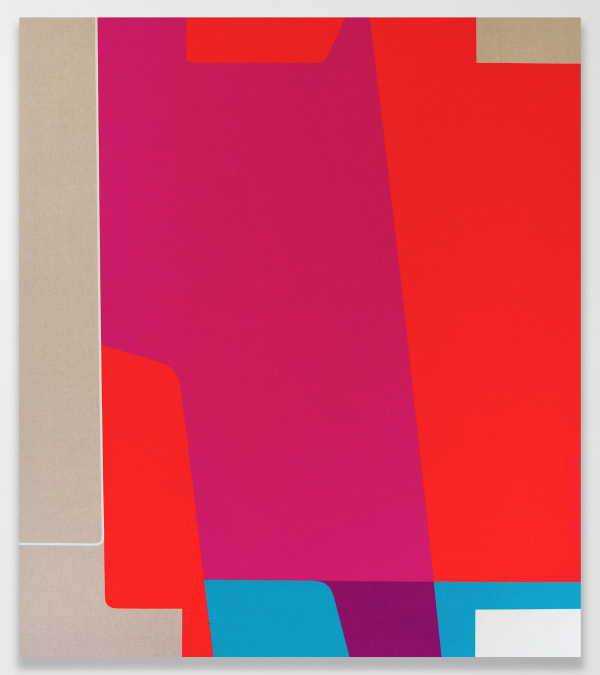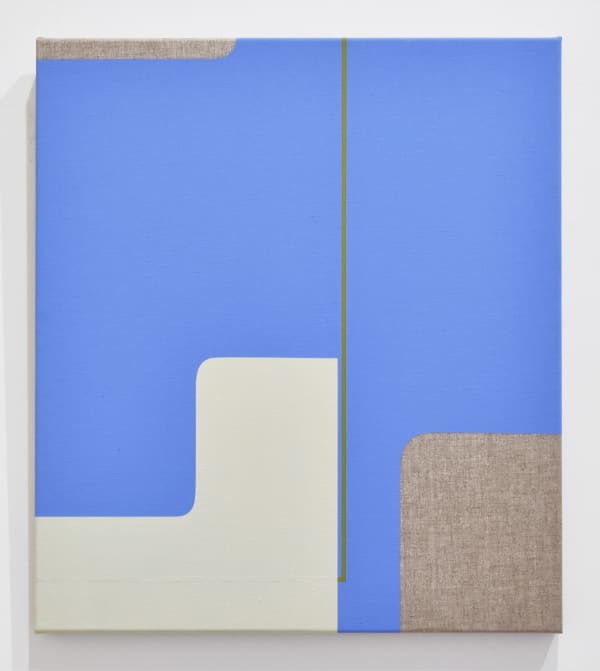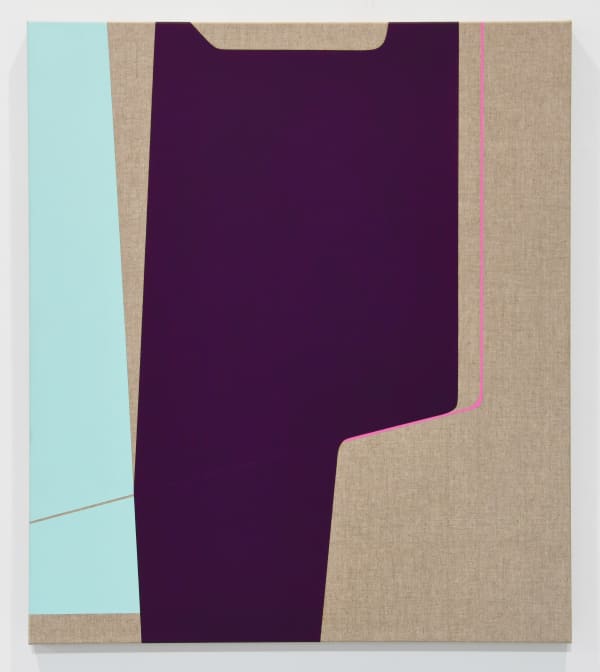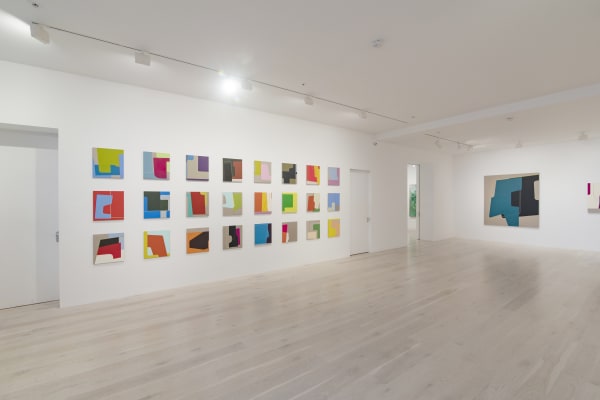Moment of Tangency: Matthew Browne
Browne’s interest in the poetics and problematics of communication manifest in paintings that evoke familiar aspects of the visual and material world around us, and refer to other paintings.
Slow Spontaneity: Matthew Browne - Essay by Emil McAvoy
A tangent is a straight line or plane that touches a curve or curved surface at a point. A tangent can also represent a completely different line of thought or action. We think of thoughts and dialogues taking different tangents – new directions which branch off from expected trajectories. We might think of individual art practices as constructive tangents too, the accumulation of focused personal experiments and innovations.
Painter Matthew Browne’s Moment of Tangency mines the artist’s longstanding interest in automatic drawing. Automatism engages processes designed to release conscious control over an artwork – such as incorporating chance – to render the unconscious mind visible. While automatism is most commonly associated with Surrealism, Abstract Expressionism and biomorphic abstraction, Browne deploys it in pursuit of new forms of hard-edged geometric painting. In Browne’s process, a painting evolves in an unplanned and improvised manner, as each new component – a coloured shape, line or layer – intuitively responds to the former. They unfold one element at a time until a composition comes together where successive lines, forms and planes meet. Browne’s work embraces traditions of geometric abstraction whilst establishing a contemporary tangent, free to explore the infinite geometries of thought and feeling – and their manifestation as painting.
Browne’s interest in the poetics and problematics of communication manifest in paintings that evoke familiar aspects of the visual and material world around us, and refer to other paintings.
Yet their fundamental ambiguity remains both elusive and open to interpretation. Browne’s selection of painting titles echoes this interest – obscure yet associative, foregrounding the open-ended nature of their potential meanings. He states: “the deciphering of language, the metaphorical positioning of a word for an event, observation, feeling or emotion, sits nicely with my thoughts on the difficulty in comprehension that painting presents for many viewers.”[1]
A key source of inspiration for Browne’s painting titles is Jon Koenig’s Dictionary of Obscure Sorrows, a modern lexicon of new terms for contemporary feelings and situations for which no singular terms currently exist.[2] Despite the lexicon’s sombre sounding title, some of these situations and feelings can be positive or neutral.One example is a series of paintings entitled Morii, a word which Koenig describes as the desire to capture a fleeting experience. Another example is the painting Keyframe, a term which Koenig defines as a moment that seemed innocuous at the time yet ended up marking a diversion into a strange new era of one’s life.
Reflecting on Koenig’s terms, Browne states:
Their unfamiliarity presents a kind of analogy to the way we might endeavour to understand a visual experience through painting. Both operate as a metaphor for experience in some way and both are undoubtedly difficult to decipher at the onset. As one begins to unravel the sound of a word and an understanding of its position and meaning, a clarity confirms upon us its role. I see paintings, or at least our understanding of paintings, in a way that connects to the experience of any unfamiliar word or language...be it from the Koenig lexicon, or from a foreign language that we are unfamiliar with. The language of painting can be seen, in a way, as parallel to the spoken word. Meanings may be genuine, heartfelt, and sincere but at first may elude immediate comprehension. We must spend time familiarising ourselves with this new language, immersing ourselves in it in order to fully activate the qualities of projection and reception that are necessary for communication.[3]
Browne’s idiosyncratic visual language is at once his and ours. It is his in the sense that Browne’s work has a recognisable aesthetic, even in its infinitely variable iterations. It is ours in the sense that the viewer ultimately determines its meaning – and at a level which is individual, subjective and non-rational. Colour relationships do much of the heavy lifting here, whether consonant or dissonant, custom-mixed or applied readymade from the tube. “Colour can bypass logical thought,” he states.[4] In this context, Browne’s use of colour foregrounds the role of subjectivity and individual feeling in the perception and reception of his paintings.
Automatism opens a space where the unexpected may enter, celebrating the potential of rendering the unconscious. While the gestures of automatic drawing and painting often seek to operate at a rapid pace ostensibly beyond the direction of the consciousness mind (the work of Max Gimblett is a local example), Browne’s is a slow spontaneity – a measured approach that balances control and abandon. Browne describes this abandon as “the suspension of knowing”.[5] In this sense he is more closely aligned with the work of German artist Tomma Abts, who holds her modestly scaled canvases in the crook of her arm while painting them as they unfold one aspect at a time.
Browne appears to shed the often self-serious position taken by geometric painters, alongside correspondingly cool, unemotional readings of their work. He taps into legacies of abstraction and deconstructs them, while pursuing a personal, highly visceral approach. His work encourages audiences to slow down just as he does – to open spaces in which to speculate and contemplate. Browne’s practice touches the trajectories of abstraction, while taking audiences on a tangent uniquely his own.
Matthew Browne Biography
Matthew Browne was born in London to New Zealand parents. He studied at Camberwell College of Arts in London, gaining a Bachelor of Arts in Painting (Honours) in 1982. Further studies in Aotearoa New Zealand at Elam School of Fine Arts, University of Auckland, led to a Master of Fine Arts (Honours) in 2000.
Browne’s career in education began with an invitation to teach at Chelsea College of Art & Design, London in 1988. Since relocating to New Zealand in 1991, he has continued to teach art, particularly drawing and painting, in both the tertiary and community sectors, including Elam School of Fine Arts and Whitecliffe College of Arts and Design. In 2013 he founded the Browne School of Art in Auckland, an independent school which employs a host of respected local artists as tutors and mentors, alongside a gallery which stages regular staff, student and alumni led exhibitions.
Browne has exhibited widely throughout Aotearoa New Zealand and the UK. His work is represented in private collections in New Zealand, UK, Australia, Denmark, Singapore, Canada and the USA. His work is held in public collections including the Parliamentary Collection, Wellington, The Royal Overseas League, London, and Wallace Arts Trust, Auckland. He was the judge of the Molly Morpeth Canaday Art Award in 2015 and won a Merit Award in the New Zealand Painting and Printmaking Award in 2009, and in the National Contemporary Art Awards in 2019.
References:
[1] Matthew Browne, email correspondence with the author, August 8, 2021.
[2] See: https://www.dictionaryofobscuresorrows.com/
[3] Matthew Browne, email correspondence with the author, August 9, 2021.
[4] Matthew Browne, phone conversation with the author, August 15, 2021.
[5] Ibid.





















